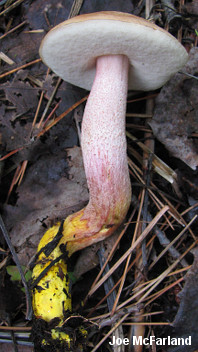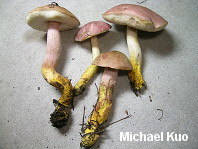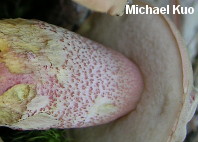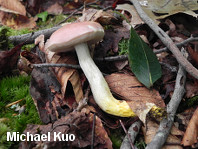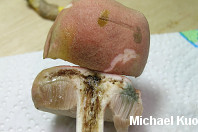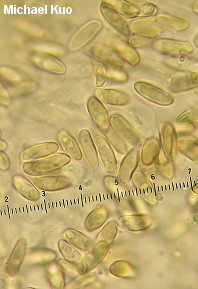| Major Groups > Boletes > Harrya chromapes |

|
Harrya chromapes [ Basidiomycota > Boletales > Boletaceae > Harrya . . . ] by Michael Kuo Here is a gorgeous bolete, easily recognized by its pinkish young cap (which becomes more brown with age), its chrome yellow stem base, and the pink scabers on the surface of its stem. It is mycorrhizal--but it appears to be mycorrhizal "generalist," able to form mycorrhizae with a wide variety of trees, including both hardwoods and conifers. In North America, Leccinum chromapes is found in the eastern and midwestern United States, in Texas, and in Mexico. Your field guide probably calls this mushroom "Tylopilus chromapes" or "Leccinum chromapes." I would love to do the same (see my mini-rant on the page for boletes), but those wacky boletologists have gone and erected an entire genus to hold this species and its rarely collected Costa Rican cousin, Harrya atriceps, which has a black cap and yellow scabers.
Description: Ecology: Mycorrhizal with a wide variety of hardwoods and conifers, appearing in diverse ecosystems; often growing alone, but also found growing scattered or gregariously; summer and fall (also over winter on the Gulf Coast); widely distributed east of the Great Plains. Cap: 3-11 cm; convex, becoming broadly convex or nearly plane; surface dry or tacky, finely velvety or nearly bald; occasionally somewhat pitted; when young pink to brownish pink or pale red, fading to pinkish tan, tan or dull yellowish; without a sterile, overhanging margin. Pore Surface: Creamy white, becoming pinkish, then brownish to reddish brown; not bruising; depressed at the stem; 1-3 round to angular pores per mm; tubes to 14 mm deep. Stem: 4-17 cm long; 1-2.5 cm wide; at maturity more or less equal or tapering to apex, but with a pinched-off base; whitish to pinkish above, chrome yellow at the base (occasionally yellow overall); finely silky or finely lined near the apex; densely covered with fine scabers, except over the base; scabers usually pinkish to reddish brown, but occasionally whitish and difficult to distinguish; basal mycelium chrome yellow. Flesh: Whitish or faintly pinkish; often pinkish beneath the skin of the cap; unchanging when sliced and exposed to air, or rarely (according to some authors) faintly bluish or yellowish in limited areas; quickly invaded in the stem by larvae; frequently brown and cavernous in the lower portion at maturity. Odor and Taste: Not distinctive. Chemical Reactions: Ammonia yellow to negative on cap surface; negative on flesh. KOH olive to brownish on cap surface; olive to brownish on flesh. Iron salts gray on cap surface; blue green on flesh. Spore Print: Pinkish brown to cinnamon brown or purplish brown. Microscopic Features: Spores 9-13 x 4-5 µ; smooth; subfusiform; hyaline to yellowish in KOH; inamyloid. Hymenial cystidia fusoid-ventricose to fusiform; up to 50 x 12 µ or larger; often scarcely projecting beyond the basidia; hyaline or yellowish in KOH; scattered. Pileipellis a tangled layer of repent or suberect hyphae up to 7 µ wide; the terminal elements with rounded apices, not swollen; hyaline to yellow or golden yellow in KOH. Caulocystidia scattered; in bundles with caulobasidia; variously shaped (subclavate, fusoid, cylindric, subcapitate, irregular); up to 48 x 15 µ; hyaline to yellowish in KOH. REFERENCES: (Frost, 1874) Halling, Nuhn, Osmundson & Manf. Binder, 2012. (Atkinson, 1900; Coker & Beers, 1943; Singer, 1945; Smith & Thiers, 1968; Snell & Dick, 1970; Smith & Thiers, 1971; Grund & Harrison, 1976; Smith, Smith & Weber, 1981; Halling, 1983; Both, 1983; Arora, 1986; Phillips, 1991/ 2005; Lincoff, 1992; Metzler & Metzler, 1992; Wolfe & Brougher, 1993; Barron, 1999; Bessette, Roody & Bessette, 2000; Halling & Mueller, 2003 ["L. cartagoense"]; Roody, 2003; Halling, 2006; McNeil, 2006; Miller & Miller, 2006; Ortiz-Santana et al., 2007; Binion et al., 2008; Halling et al., 2012.) Herb. EIU ASM 4753, ASM 5791. Herb. Kuo 09070101, 09150709, 07221001. Leccinum chromapes and Tylopilus chromapes are synonyms. Further Information Online: Tylopilus chromapes in Smith & Thiers, 1971 |
|
|
Cite this page as: Kuo, M. (2013, December). Harrya chromapes. Retrieved from the MushroomExpert.Com Web site: http://www.mushroomexpert.com/harrya_chromapes.html © MushroomExpert.Com |
